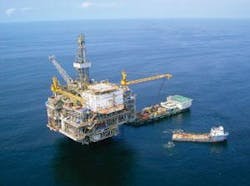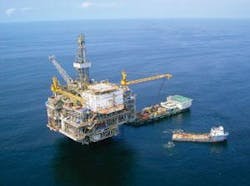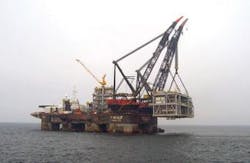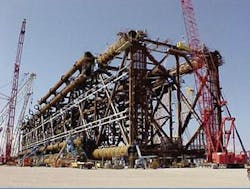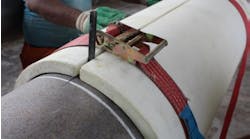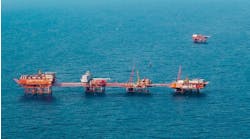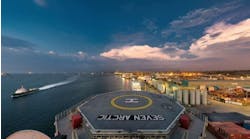Chevron starts production from first compliant tower outside GoM
Gravity-based facility is fifth tallest freestanding structure in the world
David Paganie, Senior Editor
Cabinda Gulf Oil Co. Ltd. (Cabgoc), a subsidiary of Chevron, has achieved first oil production from the $2.2-billion Benguela, Belize, Lobito, and Tomboco (BBLT) development, the first compliant piled tower (CPT) outside the Gulf of Mexico.
Chevron and partners are undertaking a two-phased program to develop the BBLT project, located on Angola’s block 14 in 1,300 ft of water. Phase 1 includes drilling and completion of more than 30 developments wells from the recently installed 12-pile, 40-slot integrated drilling and production steel compliant tower platform.
Phase 2 calls for exploitation of the Lobito and Tomboco fields via subsea wells tied back to the BBLT central hub. First production from Phase 2 is expected in early 2006, followed by combined peak production of 200,000 b/d by 2008.
The West Africa region is well known for its use of FPSOs. According to Offshore’s latest survey of the worldwide FPSO fleet (August 2005), approximately 21%, or 21 of the world’s 99 active FPSOs, were located in West African waters. With FPSOs a proven deepwater solution in the region, why switch to a new design?
Chevron uses a staged approach for capital projects, one that emphasizes “front-end” analysis during a development’s early identification and selection phases. At BBLT, the original plan called for a conventional floating production storage vessel with subsea completions, the company said, but rigorous front-end analysis convinced the development team to use a CPT. The result was cost savings of some $230 million.
Following a design competition, Chevron selected Mustang Engineering’s “bottom-founded” CPT solution for the BBLT project. The term “compliant” in CPT refers to the inherent flexibility of the tower that allows it to mitigate the forces of wind, wave, and currents.
According to Mustang, who performed front-end engineering design and pre-FEED services for the development, “Compliant towers provide bottom-founded developments with surface trees in these water depths (1,300 ft) at costs appreciably less than conventional structures due to reduced steel requirements. Other advantages of compliant towers include good constructability characteristics and the use of conventional, inexpensive drilling and production risers with dry trees.”
Mustang was awarded the engineering contract by Daewoo Shipbuilding & Marine Engineering Co., Ltd. (DSME), who was selected as the prime $700-million engineering, procurement, construction, and installation contractor. Mustang’s sister company, Alliance Engineering, was contracted to perform work on the project as well. The company was selected by Daewoo to provide project management personnel in support of several phases of the development, leading up to first production.
Chevron’s latest creation, while cost-effective, records a spot among the world’s tallest man-made structures. According to the operator, the CPT measures approximately 512 m (1,680 ft) from the seafloor to the top of its derrick. This ranks it as the fifth tallest freestanding structure in the world, standing 212 m (694 ft) taller than the Eiffel Tower.
Worldwide fabrication
The Benguela/Belize project’s components were fabricated in several locations across three continents: North America, Africa, and Asia. Cabgoc issued awards in early 2003 for the first two contracts associated with fabrication work on the project to DSME and KCA/Deutag.
DSME was awarded an $820-million contract for engineering, procurement, construction, and installation of the project’s production facilities, CPT, and the oil and gas export pipelines. KCA/Deutag with partner National Oilwell Varco picked up the $120-million contact for engineering, procurement and construction of the platform drilling rig, and the contract for the future operations and maintenance of the rig.
The KCA/Deutag team started fabrication work on the CPT’s integrated 4,600 hp platform drilling rig in September 2003. The primary steelwork fabrication was carried out by Omega Natchiq in New Iberia, Louisiana, and National Oilwell Varco supplied the complete package of drilling equipment from its product divisions in Stavanger, Edmonton, and Houston. The completed rig components were then transferred to the Galena Park yard on the Houston ship channel for assembly and commissioning.
The platform rig is capable of drilling to 30,000 ft and uses AC variable frequency drives. The completed product is fitted with a mechanical pipehandling system installed in its 1.3-MMlb hook-load derrick, which is equipped with 4,600-hp drawworks and a top drive with 60,000-ft lb torque. The rig also has three 2,200 hp mud pumps rated to 7,500 psi with a total mud volume of 4,625 bbl.
The fully integrated platform rig departed on March 11, 2005 and arrived in Angola on April 19. KCA/Deutag performed hook-up and commissioning of the drilling package in Angola and Heerema handled transportation and installation of the rig on the CPT.
DSME’s offshore division was responsible for fabrication of the production facility’s topside modules. The work was performed at the company’s yard in Okpo, South Korea. The overall topside section has a designed operating weight of 43,500 short tons, and is fitted with capacity to handle 220,000 b/d and 420,000 b/d of water re-injection. The topside production modules were loaded out in early March 2005 and arrived in Angola in early April.
The other two major components of the topside, living quarters and flare boom, were loaded out and arrived in Angola in April 2005, as well. Delta Engineering fabricated the 157-man accommodation module at its yard in Channelview, Texas, and Sonamet constructed the CPT’s drilling template with piles, leveling pile template with piles, flare boom, helideck, and related facilities, weighing over 1,600 tons, at its yard in Lobito, Angola.
Fabrication of the tower portion of the production facility was split into two sections; Kiewit Offshore Services, Ltd. built the tower base section and template, weighing over 26,000 short tons, and Technip’s Gulf Marine Fabricators (now owned by Gulf Island) constructed the tower’s top section, weighing in at almost 8,000 short tons. Both sections were fabricated in Ingleside, Texas, and were loaded out in-time for arrival in Angola in early April 2005.
The CPT’s bottom section consisting of 12 foundation piles, weighing close to 11,000 short tons, was fabricated in Ingleside, Texas, as well. The foundation piles and template arrived in Angola in December 2004, while the two sections of the tower reached Angola in April 2005, for assembly.
Cabgoc issued contract awards for the subsea portion of the project to Subsea 7 and Vetco Gray. Subsea 7 secured the $270-million contract for the 10-km tieback of three subsea drill centers to the CPT. The contractor’s workscope called for fabrication and installation of steel pipelines, flowline jumpers, connectors and umbilicals, as well as installation of the subsea manifolds.
The steel flowlines are being fabricated at the contractor’s new spoolbase in Luanda, Angola, and installation work was assigned to the company’s multipurpose pipelay vesselSkandi Navica.
Vetco Gray picked up the three-year, $125-million contract for supply of 22 horizontal subsea trees, six manifolds, and the fully integrated subsea and surface control systems. Sonamet is fabricating the subsea manifolds (three production and three water injection) at its yard in Lobito, Angola, for Vetco. The manifolds each weigh around 80 tons.
Heavy lifting
The CPT’s topside modules were lifted by Heerema’s semisubmerisbleThialf over a five-week period. Heerema Marine Contractors was selected by DSME as the topsides installation contractor.
The massive heavy-lift vessel, equipped with dual 7,100-metric ton cranes, performed 11 lifts ranging from 170 to 10,470 metric tons. The lifts began on April 20 and included the topside module support frame, north and south modules, north and south hubs, living quarters, drilling equipment structure, two drilling support modules, upper derrick and the flare boom.
One of the vessel’s lifts called for installation of the CPT’s north module, weighing 10,470 metric tons. This represents Heerema’s largest installation using theThialf’s anchorless dynamic positioning system. The vessel’s dual crane capacity provides for tandem lifts of up to 14,200 metric tons.•
